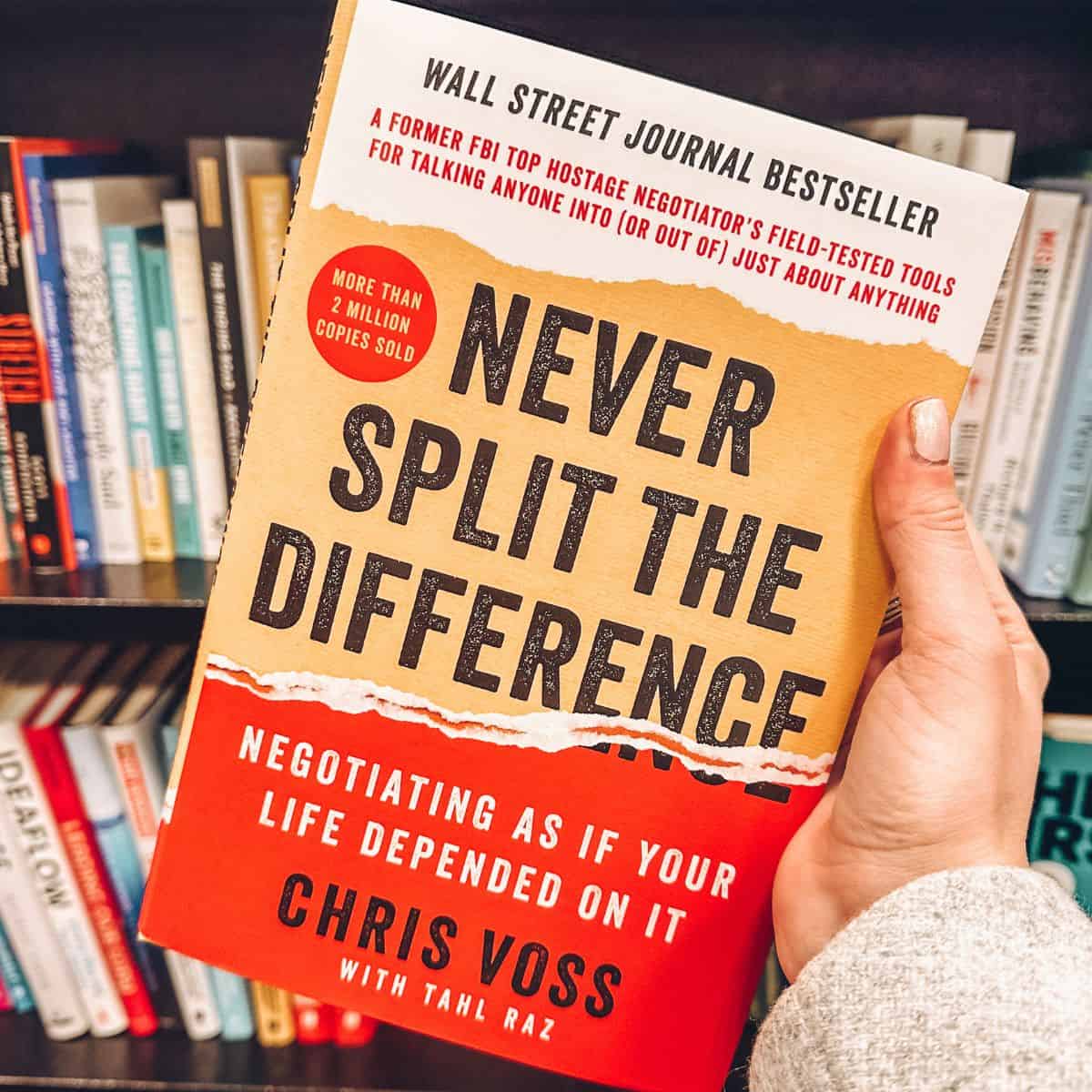This book review of Never Split the Difference by Chris Voss gives you the details of this immensely interesting and helpful negotiation “must read” book. And because this is a book pairings blog “where books meet lifestyle,” I have also provided some tips from the book and recommended pairings for further learning.

Book Review: Never Split the Difference by Chris Voss
Never Split the Difference is a book I have been wanting to share with others since before I had a blog. I’ve had a note filled with my annotations from the book on my phone for YEARS. And, as an attorney, I have spotted several other attorneys walking around with copies of it at depositions and in court. However, we all engage in negotiations on a daily basis, from interpersonal communications to deal-making, and so this book is a negotiation must-have tool for all of us, no matter your career.
It’s written by a former international hostage negotiator for the FBI, and it provides his best negotiation tactics in situations where there’s no wiggle room to lose, along with some of his “war stories” to illustrate his tips. Below is a list of the negotiation tips I like to refer back to.
Helpful Negotiation Strategies and Tips
- Respond, “I’m sorry, [then mirror what they said as a question].” Then be silent.
- Label: Say, “It seems you [insert feeling].” Don’t talk about yourself.
- Speak in one of three voice tones: “nighttime radio DJ voice” (calm and cool), a positive voice or an assertive voice. But use the assertive voice only rarely and for something like, “We don’t do xyz.” Maintain the DJ voice when dealing with hostility.
- Use labels and mirroring (repeating their last few words) to build rapport and show empathy.
- Allow people to say no. It preserves their autonomy and security and then they may come off their position later. For example: “It seems you want [fill in the blank] to happen? Is now a bad time to talk?” Or, “What would you say “no” to?” Or, “Have you given up on this?”
- Get people to say, “That’s right.” This shows you understand their position. This is the opposite of getting them to say, “You’re right.” The latter just means they are appeasing you because they want you to go away.
- It’s OK to let people know your deadline, so they can act quickly.
- Use the word “fair.” People like to be treated fairly. For example, you can say, “I want you to be treated fairly, and if I’m treating you unfairly, let me know.”
- To get real leverage, show them what they have to lose.
- Know the “emotional drivers” behind the problem people want to be solved, not just the solution.
- Let the other side go first in monetary negotiations.
- If you present a low offer, anchor their emotions by stating that you know it’s low, but you wanted to present it.
- Use a number range with the low number being what you actually want.
- Use odd numbers. They sound more thoughtful and permanent.
- Ask open-ended questions: “How am I supposed to do that?” “What is your objective?” “What is your biggest problem?” You may be able to reject their demand by problem-solving without having to counter anything and, even if you don’t, you get valuable information.
- Stay firm on non-salary requests when negotiating a job offer. If they can’t give you the request, they may increase the numbers. Also, ask them what will make you successful as an employee and argue you will meet that criterion.
- Diffuse a hostile person by apologizing. For example, “I know that was harsh…”
- Instead of saying, “No,” say things like, “I can’t do that” or “that’s not going to work for me.”
- If someone makes you go first you can casually state what someone else would offer/demand so you don’t lock yourself in.
- If someone is showing reluctance to a change when you make a demand/offer, ask them, “Why would you change something that’s working for you?” It puts them in a position of making the case for you, rather than defending their current status.
- PREPARE: Think about the goal, best and worst-case scenarios, facts that led up to negotiation, 5 labels you can project on them and 3-5 calibrated questions you can ask.
Although I have shared a lot of tips, Never Split the Difference is a book that must be read to fully understand and utilize them. It’s an absolute game-changer in the world of negotiation.
Book Pairings
For more like Never Split the Difference:
- Save and practice, practice, practice these tips.
- Watch Mindhunter on Netflix for some dramatized, similar scenarios to Voss’s life experiences.
- Or, for a laugh, watch “The Negotiation” episode of The Office, in which Michael Scott tries to get the upper hand with salary negotiation techniques only to be overshadowed by the fact he is mistakenly wearing … a women’s suit. It’s one of my favorites and always makes me laugh out loud.
- Read my list of the best books for graduates for more self-help books.
- Read LeanIn.org’s negotiation tips for women.
I hope this book review of Never Split the Difference by Chris Voss inspires you to pick up this important book and/or continue to learn more about helpful negotiation tactics.
Buy Never Split the Difference:

